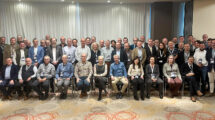Why a new network
SURF began renewing the service layer of the SURF network in the summer of 2018. At that time, the migration of the optical layer was almost complete. Renewal of the service layer was necessary because the equipment in the SURFnet7 network was outdated and no longer met our requirements and the wishes of the institutions. However, equipment replacement was not the main objective when building the new SURFnet8 network. The main objective was to realise a new network vision, with automation & orchestration playing a leading role. In this way, SURF now has the possibilities to respond to the future wishes of users.
Automation & orchestration
Standardisation of all network-related information and the development of a proprietary orchestration platform made it possible to automatically configure the SURFnet8 network. The migration to the SURFnet8 network has therefore largely been an automated process. Using the flexible architecture of the network and the new orchestration platform, SURF can therefore now develop new services, such as virtual firewalls. Furthermore, institutions will soon be able to request automated services and link their own applications to the network. In this way, they can easily experiment with new technologies.
Planning SURFnet8
From the start of the SURFnet8 project in 2016, the aim was to complete the migration before the end of 2020. We knew that this planning was challenging. In addition to the challenge of developing a new orchestration platform, a lot of physical work simply had to be done. Together with our partner Quanza, we rolled up our sleeves. We replaced the network equipment at all 279 locations in the network. All fibre-optic connections between these locations were repaired and reconnected. And all 633 services from all institutions were migrated to the new equipment. Much of the configuration work was automated so that hardly any time was wasted. But even more importantly, institutions suffered as little inconvenience as possible.
A brief retrospect: migration of the service layer
In 2018, initially we replaced the two core routers in Amsterdam. In the first half of 2019, we built our core network at 40 main locations. On 2 July 2019, we migrated the very first internet connection to SURFnet8 at the SURF office in Utrecht, fully automated . Until the end of 2019, we then migrated 32% of all internet services, but that was only 12% of all services. This meant that we still had to complete 88% of the work in 2020. In March last year, there was an additional complication when the Corona virus completely disrupted our normal way of living and working. Nevertheless, we found a good way of working within the new measures and we managed to keep the migration going. In May, we struck a major blow with the migration of the NetherLight platform. Compared to other years, the summer was a fairly productive period. But at the end of the summer holidays, the counters were only at 50% of the total number of migrated connections and locations; time for a good final sprint!
Last Lights
After the summer Quanza and SURF worked hard to transfer almost half of all institutions from SURFnet7 to SURFnet8. Despite the difficult times, institutions cooperated fully; for this we are very grateful to everyone! Thanks to this joint effort, we were able to complete the migration in 2020. On 18 December, the last connection at the Rijksmuseum’s depot in Lelystad was reconnected. This completes the migration to the SURFnet8 network!
More on SURFnet8
- read more on the SURFnet8 project







